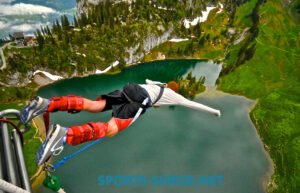Adventure air sports have surged in popularity, offering thrill-seekers unparalleled experiences that combine the exhilaration of flight with physical challenges. From trampoline parks to wingsuit flying, these activities cater to a wide range of enthusiasts. In 2024, the landscape of adventure air sports has evolved significantly, introducing new attractions and making existing ones more accessible.
Table of Contents
ToggleTrampoline Parks: The Gateway to Aerial Fun
Trampoline parks have become a staple in urban entertainment, providing a safe environment for individuals to experience the joy of bouncing and aerial maneuvers. Facilities like Adventure Air Sports have set the standard with state-of-the-art centers offering a variety of attractions.
Adventure Air Sports Facilities: With locations in Kennesaw, Rock Hill, and Alpharetta, Adventure Air Sports invites guests to experience their world-class recreation parks. Each facility boasts a massive trampoline main court with parkour elements, one of the largest Ninja Warrior obstacle courses in the area, indoor zip lines, climbing walls, and foam pits. These attractions cater to all ages, making them ideal for family outings, birthday parties, and group events.
Safety and Inclusivity: Modern trampoline parks prioritize safety with trained staff and well-maintained equipment. They also offer inclusive programs, such as toddler times and sessions for individuals with special needs, ensuring everyone can participate.
Wingsuit Flying: The Pinnacle of Human Flight

For those seeking the ultimate aerial adventure, wingsuit flying offers an unparalleled experience. This extreme sport involves jumping from aircraft or high elevations while wearing a specialized suit that allows for controlled flight.
Liam Byrne’s Journey: At 23, Liam Byrne from Stonehaven, Aberdeenshire, has become one of the youngest top-tier base jumpers and the current British champion in performance wingsuit flying. Inspired by nature documentaries and a desire to emulate birds, Liam pursued his dream of flight, becoming a real-life “Superman.” His adventures are chronicled in the BBC Scotland documentary “The Boy Who Can Fly,” showcasing his dedication and the meticulous preparation required for each jump.
Safety Measures: Wingsuit flying is inherently risky, demanding rigorous training and strict adherence to safety protocols. Aspiring wingsuit flyers typically progress from skydiving, accumulating significant experience before attempting wingsuit jumps.
Skydiving: An Inclusive Adventure

Skydiving has long been a bucket-list activity for thrill-seekers. In recent years, the sport has become more inclusive, accommodating individuals with disabilities.
Adaptive Skydiving: Modern skydiving centers have adapted their facilities and procedures to welcome thrill-seekers with disabilities. For instance, Skydive Elsinore in California is renowned for its commitment to accessibility, offering tailored experiences for individuals with physical and sensory disabilities. The use of dual-harness systems and personalized support ensures a safe and exhilarating experience for all participants.
Notable Achievements: Paralympian Lonnie Bissonnette made history with a wheelchair skydive, demonstrating the advancements that make such feats possible. These developments underscore the inclusivity of skydiving, allowing a broader audience to experience the thrill of freefall.
Airshows: Spectacles of Aerial Mastery
Airshows offer the public a chance to witness breathtaking aerial performances and the latest in aviation technology. In 2024, these events have expanded their offerings to captivate audiences further.
Pacific Airshow Gold Coast: Following a successful debut in 2023, the Pacific Airshow returned to the Gold Coast in 2024 with an expanded lineup. Highlights included performances by the Royal Australian Air Force 100 Squadron heritage aircraft, the RAAF Roulettes aerobatic display team, and the US Navy Leap Frogs parachute team. The event attracted 250,000 visitors and generated significant economic benefits for the local community.
Economic Impact: Airshows like the Pacific Airshow not only provide entertainment but also boost local economies through tourism and related activities.
STOL Competitions: Showcasing Precision Flying
Short Takeoff and Landing (STOL) competitions have gained popularity, highlighting pilots’ skills in operating aircraft within minimal distances.
Integration into Simulation: Microsoft Flight Simulator 2024 introduced customizable planes to support the growing sport of competitive STOL. This addition allows virtual pilots to engage in STOL competitions, mirroring real-life events and fostering interest in aviation.
Real-World Competitions: Organizations like National STOL run competitions across the U.S., where pilots demonstrate their precision and control in short takeoff and landing scenarios.
Indoor Skydiving: Accessible Aerial Thrills
Indoor skydiving facilities have made the sensation of freefall accessible without the need for jumping from an aircraft.
Wind Tunnel Experiences: Vertical wind tunnels simulate the freefall experience, allowing participants to float on a cushion of air. These facilities cater to various skill levels, from beginners to experienced flyers practicing maneuvers.
Training and Recreation: Indoor skydiving serves both as a training tool for professional skydivers and an exciting recreational activity for the general public.
Evolving Trends in Adventure Air Sports

The adventure air sports industry continues to innovate, introducing new attractions and enhancing existing ones.
Redevelopment Projects: Abandoned facilities, such as the indoor ski slope in Glasgow, are being transformed into new entertainment venues featuring attractions like e-karting and e-sports areas. These projects aim to rejuvenate sites and offer fresh experiences to the public.
Technological Integration: Advancements in technology have led to the incorporation of virtual reality and interactive elements in air sports attractions, providing immersive experiences that are captivating for participants of all ages. VR wingsuit simulators, augmented reality (AR) skydiving, and drone-assisted zip lines are just a few examples of how technology is reshaping the adventure air sports landscape. These innovations not only enhance the experience but also make these activities safer and more accessible to new audiences.
Environmental and Safety Considerations

As adventure air sports grow, so does the importance of sustainability and safety in the industry. Organizers and facilities are increasingly adopting measures to minimize environmental impact and ensure participant safety.
Eco-Friendly Practices:
-
- Several air sports organizations have shifted towards using eco-friendly materials for equipment, such as biodegradable parachutes and reusable wingsuit fabrics.
- Events like airshows are incorporating carbon offset programs and green energy solutions to reduce their ecological footprint.
Enhanced Safety Standards:
-
- Ongoing advancements in equipment, such as automatic activation devices (AADs) for parachutes and improved wingsuit designs, have significantly increased safety.
- Comprehensive training programs and mandatory certifications ensure that participants are well-prepared for the challenges of air sports.
Insurance and Liability
-
- With the rising popularity of these activities, the availability of insurance policies for adventure air sports enthusiasts has increased. These policies cover injuries and liabilities, ensuring peace of mind for participants.
Health Benefits of Adventure Air Sports
Engaging in adventure air sports not only offers adrenaline-pumping thrills but also delivers various physical and mental health benefits:
- Physical Fitness: Activities like skydiving, indoor climbing, and trampoline jumping help improve cardiovascular health, muscle strength, and overall endurance.
- Mental Well-being: The thrill of air sports reduces stress and anxiety by triggering the release of endorphins. The sense of accomplishment after completing a jump or aerial maneuver boosts confidence and mental resilience.
- Teamwork and Social Connections: Many air sports, such as group skydiving and STOL competitions, foster camaraderie and encourage participants to work as a team, promoting social interaction.
Future of Adventure Air Sports
The future of adventure air sports looks promising, with a focus on innovation, accessibility, and sustainability:
- Hybrid Experiences: Combining air sports with other activities, such as VR-enhanced indoor skydiving or eco-tours via paragliding, is set to attract new audiences.
- Global Expansion: Adventure air sports are becoming increasingly popular in regions previously underserved by these activities, such as parts of Asia and Africa.
- Youth Engagement: Programs tailored to younger audiences, including adventure camps and beginner-friendly courses, are fostering interest in air sports from an early age.
Getting Started in Adventure Air Sports
If you’re interested in exploring adventure air sports, here are some steps to take:
- Research Local Facilities: Look for reputable centers near you that offer the activities you’re interested in.
- Start Small: Begin with beginner-friendly options, such as indoor skydiving or trampoline parks, before moving on to more advanced air sports.
- Take Training Seriously: Enroll in certified courses and pay close attention to safety protocols.
- Connect with the Community: Join local clubs or online groups to meet like-minded individuals and gain insights from experienced participants.
Conclusion
Adventure air sports are more than just high-octane thrills—they are gateways to new experiences, personal growth, and unparalleled perspectives of the world. From soaring through the skies in a wingsuit to mastering precision landings in a STOL competition, there’s something for everyone in this dynamic and ever-evolving industry. As advancements in technology and safety continue, and as accessibility improves, adventure air sports are poised to reach new heights, offering endless possibilities for those seeking excitement, challenge, and a touch of the extraordinary.
FAQs about Adventure Air Sports
What types of activities are considered adventure air sports?
Adventure air sports include activities such as skydiving, paragliding, hang gliding, wingsuit flying, bungee jumping, and indoor skydiving. These sports involve elements of flight or aerial acrobatics, providing participants with unique and adrenaline-pumping experiences.
What are the age and health requirements for participating in adventure air sports?
Age and health requirements vary depending on the specific activity and the regulations of the service provider. For instance, some trampoline parks have designated areas for younger children, such as The Bowl for ages 7 and under, ensuring safety and age-appropriate fun. Generally, participants should be in good health without any conditions that could be exacerbated by physical exertion or high altitudes. It’s essential to consult with the specific operator and, if necessary, a healthcare professional before participating.
What safety measures are in place for adventure air sports?
Safety is a top priority in adventure air sports. Operators implement various measures, including:
- Trained Staff: Flight crews and instructors monitor compliance with park rules and assist with safe practices.
- Equipment Maintenance: Regular inspections and maintenance of equipment, such as trampolines and harnesses, are conducted to ensure they are in optimal condition.
- Safety Gear: Participants are often required to wear appropriate safety gear, such as helmets, harnesses, and specialized clothing, to minimize injury risks.
- Clear Guidelines: Operators provide comprehensive safety instructions and guidelines, including safety videos and posted signage, to educate participants on best practices.
Do I need prior experience or training to participate in adventure air sports?
Many adventure air sports are designed to accommodate beginners and offer training sessions or introductory courses. For example, indoor skydiving facilities provide training for first-time flyers, while trampoline parks offer areas suitable for all skill levels. However, more extreme sports like wingsuit flying or advanced paragliding typically require prior experience and training. It’s advisable to check with the specific provider regarding experience requirements and available training programs.
What should I wear when participating in adventure air sports?
Appropriate attire is crucial for safety and comfort. Participants are generally advised to wear:
- Comfortable, Athletic Clothing: Clothes should be free of hanging zippers, belts, and strings to prevent entanglement.
- Secure Footwear: Some facilities require specific footwear, such as grip socks in trampoline parks, to enhance safety.
- Removal of Accessories: It’s recommended to remove all jewelry and empty pockets to prevent loss or injury.
Specific dress codes may vary by activity and provider, so it’s best to consult with the operator beforehand.
How can I book a session or event for adventure air sports?
Booking procedures differ among providers. Many facilities offer online booking systems for individual sessions, group events, or parties. For example, Urban Air Adventure Park provides an online platform to book parties and events, with detailed FAQs to assist customers. It’s recommended to book in advance, especially for group events, to secure your preferred date and time.

